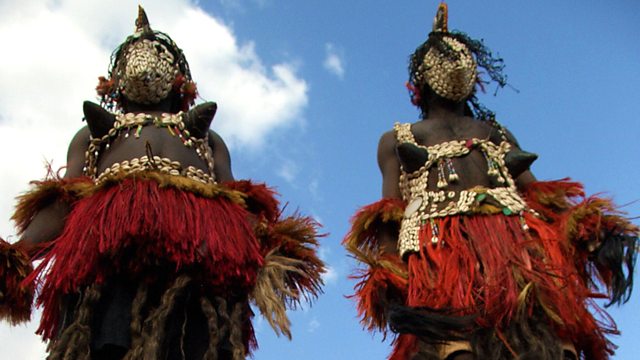Ms Koné, a tall 60-year-old with cropped greying hair, says the men have nothing to worry about.
Koné女士60岁,高个,灰白短发,她认为男性没什么好担心的。
Her marionettes do not have spirits or powers because they are “modern”, made of clay and papier-mâché rather than wood.
她做的木偶没有灵魂或超能力,因为这些木偶是“现代的”,使用黏土和纸胶混合物制成,而非木头制作。
She abjures the old-fashioned kind.
她正式宣布放弃过时的做法。
“I would never touch them,” she says.
“我永远都不会用那种方法,”她说。
“The marionette itself couldn’t do anything, but the men around it could do very bad things.”
“木偶本身做不了什么,但木偶周围的人却可以做非常坏的事。”

She grew up in Koulikoro, about an hour from Bamako on the banks of the Niger river, a town known for its marionettes, masks and unique, sacred statuettes that represent the dead.
她在库利科罗长大,从巴马科到尼日尔河岸边大约一个小时,这座城镇以木偶、面具和代表死者的独特神圣雕像而闻名。
She was born into a noble family in Mali’s complex caste system, rather than an artistic one, and her parents did not support her ambitions.
她出生在马里复杂的种姓制度下的一个贵族家庭,并非艺术世家,她父母也并不支持她的雄心壮志。
“It was difficult for my family to accept,” she says.
“我的家人都很难接受,”她说。
Of 12 siblings, she is the only artist, and the only daughter who chose not to have children, believing they would hamper her career.
在12个兄弟姐妹中,她是唯一的艺术家,也是唯一一个选择不生孩子的女儿,因为她认为孩子会妨碍她的事业。
Coming of age in the early decades of independence, she was a beneficiary of the investment in the arts made by Modibo Keïta, Mali’s first president (from 1960-68).
在马里独立后的最初几十年里,她受益于第一任总统莫迪博·凯塔(1960-68在任)对艺术的投资。
His government “understood that the arts were a very important part of creating a national identity and bringing people together,” says Mary Jo Arnoldi, a curator at the National Museum of Natural History in Washington and an expert on marionette culture.
凯塔的政府“明白艺术是创造国家认同和把人民团结在一起的重要组成部分,”华盛顿国家自然历史博物馆馆长、木偶文化专家玛丽·乔·阿诺尔迪表示。
Ms Koné was educated at the National Institute of the Arts (INA), a cutting-edge college that, says Ms Arnoldi, “broke down gender and caste boundaries” and produced some of Mali’s finest artists.
Koné女士曾在国家艺术学院上学,阿诺尔迪说,“这是一所前沿大学,打破了性别和种姓歧视,”诞生了马里最好的一批艺术家。
译文由可可原创,仅供学习交流使用,未经许可请勿转载。













